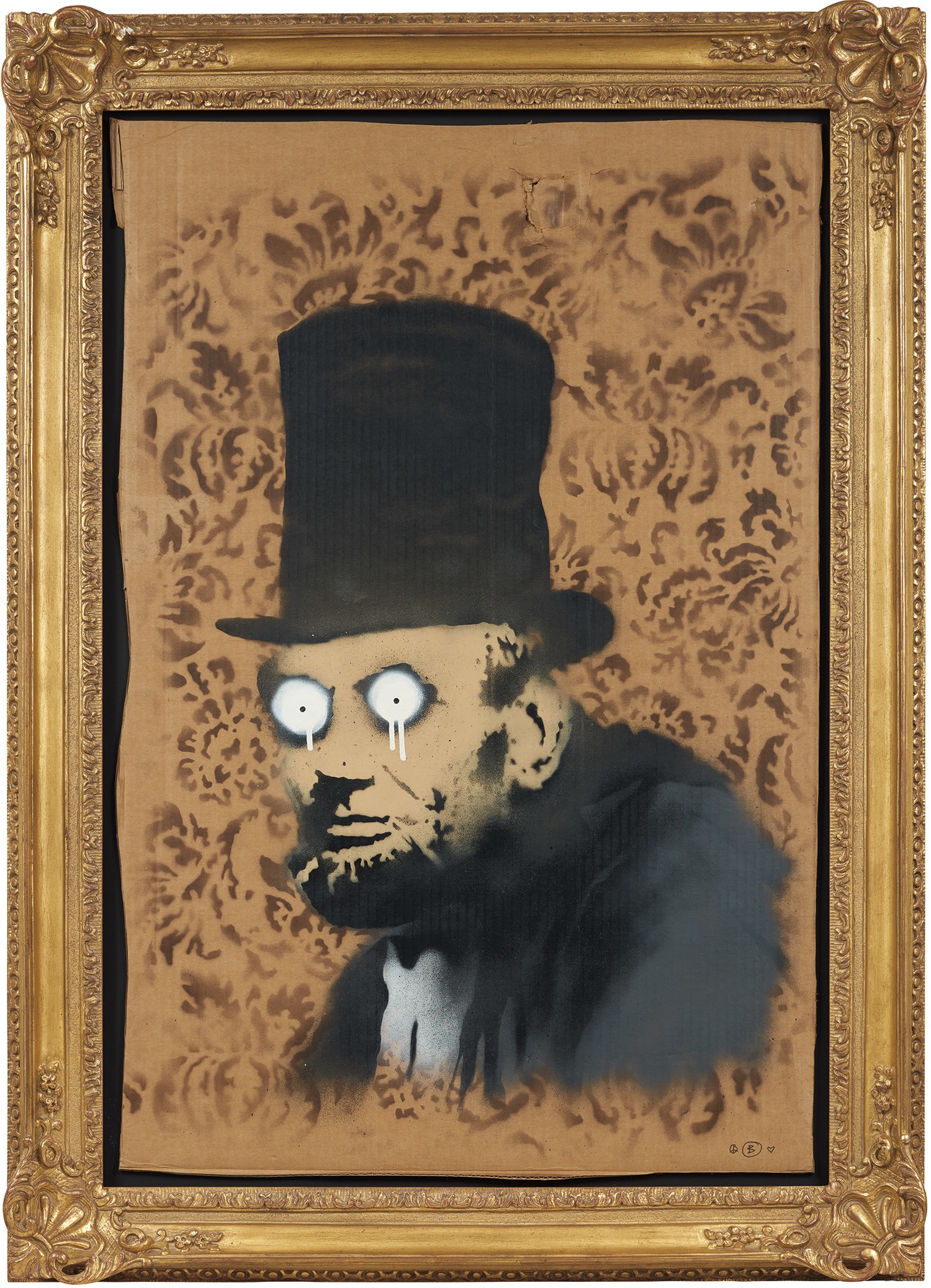

28◆
Banksy
Abe Lincoln
Full-Cataloguing
These two pictures on cardboard—from a series of only three—were created in 2008 when Banksy visited New Orleans, three years after the devastation of Hurricane Katrina. There, Banksy used the still-tattered urban fabric of New Orleans as an eloquent backdrop for his critiques of the situation. Banksy’s works encapsulated sympathy, anger and above all humour, reacting accusingly to the inadequate aid and slow subsequent clean-up operations there. In one case, Banksy painted Abraham Lincoln as a homeless man, pushing a trolley full of goods, using the same stencil he would employ for these works on cardboard. The building upon which Banksy had painted his image of Lincoln has since been demolished to make way for a healthcare facility.
Banksy’s use of the instantly-recognisable features of Lincoln as a visual theme demonstrated his laser-sharp sense of satire. Lincoln was the great figurehead of the emancipation movement, liberating the slaves of the Southern states—many of whose descendants remain at a socio-economic disadvantage throughout America. During Hurricane Katrina, that legacy of structural discrimination was felt all the more keenly as the poorer black areas of New Orleans suffered the greatest losses when the levee broke. Depicting Lincoln walking the streets, pushing his cart, searingly highlighted the shortcomings of his political descendants. After all, Lincoln, like the Bush administration on whose watch Katrina hit, was a Republican. In these distorted, dystopian depictions, the conundrums provided by historical hindsight are explored to different effect, with Banksy presenting a Lincoln who is less an emancipator or a martyr and more an ectoplasmic boogieman.
Lincoln was one of the first US Presidents to make use of photography in order to promote himself. In the years leading up to his first presidential election, photographs were disseminated to give him a more human aspect, countering rumours of his unusual height and supposed ugliness. Lincoln’s success in making himself instantly recognisable, combined with his assassination, resulted in a strong pictorial legacy. This in turn makes Lincoln all the more apt as a subject for Bansky’s ghost-train-style interventions. The iconic image has been converted, with Banksy deflating the reverence that often surrounds Lincoln’s legacy, and instead showing him as a comical ghoul.
Banksy’s mural campaign in New Orleans, where these two Abe Lincoln works were created, received largely positive acclaim, although inevitably some of the works were defaced, removed or otherwise destroyed. Subsequently, Banksy himself would reflect upon the campaign with his customary wit and self-deprecation: ‘I wanted to highlight the state of the clean-up operation. Only later did it dawn on me that if you choose to do this by drawing all over their stuff, you’re actually only slowing down that clean-up operation’ (Banksy, quoted in G. Shove & P. Potter, Banksy: You are an Acceptable Level of Threat, Darlington, 2018, unpaginated).
Banksy
British | 1975Anonymous street artist Banksy first turned to graffiti as a miserable fourteen year old disillusioned with school. Inspired by the thriving graffiti community in his home city, Bristol, Banksy's works began appearing on trains and walls in 1993, and by 2001 his blocky, spray-painted works had cropped up all over the United Kingdom. Typically crafting his images with spray paint and cardboard stencils, Banksy is able to achieve a meticulous level of detail. His aesthetic is clean and instantly readable due to his knack for reducing complex political and social statements to simple visual elements.
His graffiti, paintings and screenprints use whimsy and humour to satirically critique war, capitalism, hypocrisy and greed — with not even the Royal family safe from his anti-establishment wit.